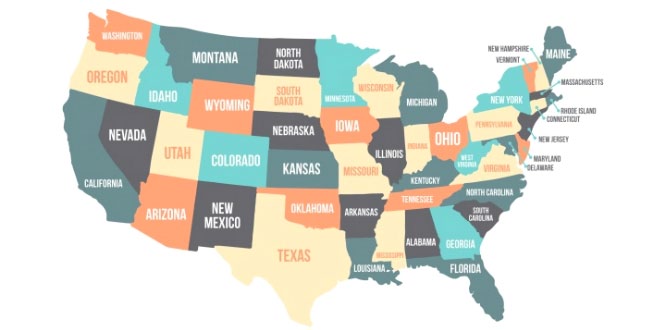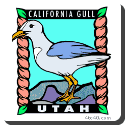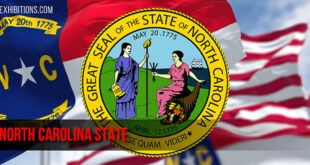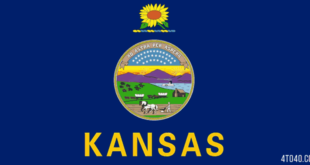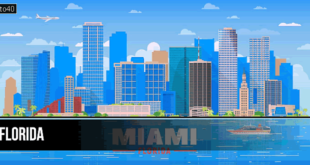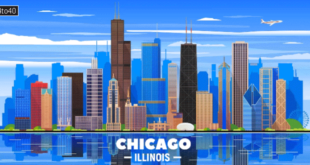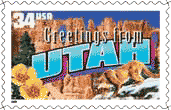
Except for a projection of Wyoming into its northeastern corner, Utah State would be rectangular in shape, measuring 440 km (275 mi) from east to west and 555 km (345 mi) from north to south. Settled by Mormon pioneers fleeing persecution in Illinois, Utah now has a population that is more than two-thirds Mormon. The state derives its name from the Ute Indians, who live in the Uinta Basin southeast of the capital, Salt Lake City.
Utah State: Land & Resources
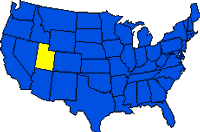 The spine of the ROCKY MOUNTAINS runs down the middle of Utah, with the COLORADO PLATEAU to the east and the GREAT BASIN to the west. The part of the Rockies keeping to the main north-south axis is called the WASATCH RANGE. The Uinta Mountains, extending more than 160 km (100 mi) just below the Utah-Wyoming border, represent the longest east-west-trending range in the United States; Utah’s highest point, Kings Peak, at 4,123 m (13,528 ft), lies within this range.
The spine of the ROCKY MOUNTAINS runs down the middle of Utah, with the COLORADO PLATEAU to the east and the GREAT BASIN to the west. The part of the Rockies keeping to the main north-south axis is called the WASATCH RANGE. The Uinta Mountains, extending more than 160 km (100 mi) just below the Utah-Wyoming border, represent the longest east-west-trending range in the United States; Utah’s highest point, Kings Peak, at 4,123 m (13,528 ft), lies within this range.
During its geologic history the Colorado Plateau gradually uplifted, causing the Colorado River and its tributaries to cut deep canyons and expose rock layers varying in color from white to orange, pink, and red. The Great Basin–the third largest region of interior drainage in the world–encompasses steep mountain ranges separated by broad desert flats.
Rivers and Lakes
Eastern Utah drains into the COLORADO RIVER and its branches; major tributaries of the Colorado include the GREEN RIVER and the San Juan. Streams in the western part of the state–such as the Jordan, Bear, Provo, Sevier, and Weber–flow into the Great Basin. The Virgin River in southwestern Utah empties into Lake Mead. In the extreme northwestern corner of the state, the Raft River drains into the Snake River.
In prehistoric times, Lake Bonneville, an inland sea, covered a large part of western Utah. Utah’s most famous body of water, the GREAT SALT LAKE–the largest natural lake west of the Mississippi and the largest salt lake in the Western Hemisphere–is a remnant of Lake Bonneville, as are the BONNEVILLE SALT FLATS. Utah Lake, the state’s largest natural freshwater lake, is dwarfed by the artificial Lake Powell–300 km (185 mi) from end to end, with an irregular shoreline.
Climate
Utah is the second driest state in the nation, with an average annual precipitation of 330 mm (13 in). Whereas the Great Salt Lake Desert receives only 127 mm (5 in) of precipitation per year, however, part of the Wasatch Range receives about 1,020 mm (40 in).
During the summer, average temperatures range between 18 deg C (65 deg F) and 28 deg C (83 deg F). Salt Lake City, for instance, has an average temperature in July of 25 deg C (77 deg F). In winter, temperatures fall below freezing, except in the southwestern corner of the state, where Saint George has an average January temperature of 4 deg C (39 deg F).
Utah State: History
Prehistoric humans arrived in the Great Basin more than 10,000 years ago, practicing a hunting and gathering economy. The earliest ANASAZI, known as the Basket Makers, developed their culture on the Colorado Plateau over 2,000 years ago; they were followed by the PUEBLO Indian tribes, whose cliff dwellings and granaries can still be seen in southeastern Utah. More recent arrivals were the Ute, Paiute, Goshiute, and Navajo Indians, who inhabited the state when the first white settlers arrived.
Early European Explorers
In 1776 two Franciscan missionaries, Silvestre Velez de ESCALANTE and Francisco Atanasis Dominguez, led an expedition into the “Northern Mystery” in order to establish a road from Santa Fe to the Spanish missions in California. By the mid-1820s, fur trappers and traders, including William Henry ASHLEY, James BRIDGER, and Jedediah Strong SMITH, had arrived; two other traders, Peter Skene Ogden and Etienne Provost, have given their names to Utah’s second and third largest cities, Ogden and Provo.
In 1843-44, John C. FREMONT, of the U.S. Army Topographical Engineers, conducted the first scientific survey of the Great Basin. Also during the 1840s several parties of settlers traversed northern Utah on their way to California. The Bartleson-Bidwell party of emigrants made their journey in 1841, crossing the Great Basin on the famous Overland Trail. In 1846 the ill-fated DONNER PARTY blazed the first trail through Emigration Canyon–the same route followed a year later by the Mormon pioneers.
The Mormons
The next chapter in Utah’s history began at Carthage, Ill., on June 27, 1844, when Joseph SMITH, the founder of Mormonism, and his brother Hyrum were taken from jail and shot by a hostile mob. Persecution of Smith’s followers–called Mormons–continued, and in the spring of 1847 most of them headed west, led by Brigham YOUNG. The first pioneers entered the Great Salt Lake valley in July 1847, and other companies arrived soon after.
When the Mormons came to Utah, it still belonged to Mexico. A year later, at the conclusion of the Mexican War, it became part of the United States, and in 1849 the Mormons established the State of Deseret (a name from the Book of Mormon meaning “honeybee” and signifying industriousness) and requested admission to the Union. Congress, however, refused to recognize Deseret–which stretched from Oregon to Mexico and as far west as the Sierra Nevada–and instead created the Territory of Utah, covering a much smaller area, with Brigham Young as governor.
Soon conflicts broke out between the Indians, especially the Ute, and the new settlers. Intermittent fighting continued until 1867, when the Ute settled on a reservation.
Before long, antagonisms developed between Utah and the federal government, which opposed the Mormon practice of polygamy. During the Utah War (1857-58), President James Buchanan sent troops to Utah, along with a new governor. During this period of tension and resentment, a party of Mormons led by John Doyle LEE attacked a group of non-Mormons traveling through the territory in the so-called MOUNTAIN MEADOWS MASSACRE (September 1857). The territory continued to make requests for statehood, but Congress always refused, until 1896, six years after the Mormons renounced their practice of polygamy.
Industrialization
The completion of the transcontinental railroad in 1869 brought new settlers–many of them non-Mormon–and a boom in both agriculture and industry. Silver, gold, lead, and zinc were discovered, and large-scale copper production began in 1907. Soon several new irrigation projects, notably that on Strawberry River (1913), brought thousands of hectares of additional land under cultivation.
The two world wars stimulated mining and manufacturing, and by the early 1960s, Utah was no longer primarily an agricultural state. Hydroelectric projects such as those at Flaming Gorge and Glen Canyon dams (1964) also encouraged industrial growth and urbanization. During the 1980s service industries and tourism expanded, broadening Utah’s economic base.
Utah State: Land
- Area: 219,901 sq km (84,904 sq mi); rank: 11th.
- Capital and largest city: Salt Lake City (1990 census, 159,936).
- Counties: 29.
- Elevations: highest–4,123 m (13,528 ft), at Kings Peak; lowest–610 m (2,000 ft), at Beaverdam Wash (creek).
 Kids Portal For Parents India Kids Network
Kids Portal For Parents India Kids Network
